Weld spatter is a common occurrence in different welding methods. Fundamentally, these are droplets of molten material generated at or near the welding arc.
A commonly asked question in the welding world, and usually among beginners, is what causes welding spatter and how to solve the issues.
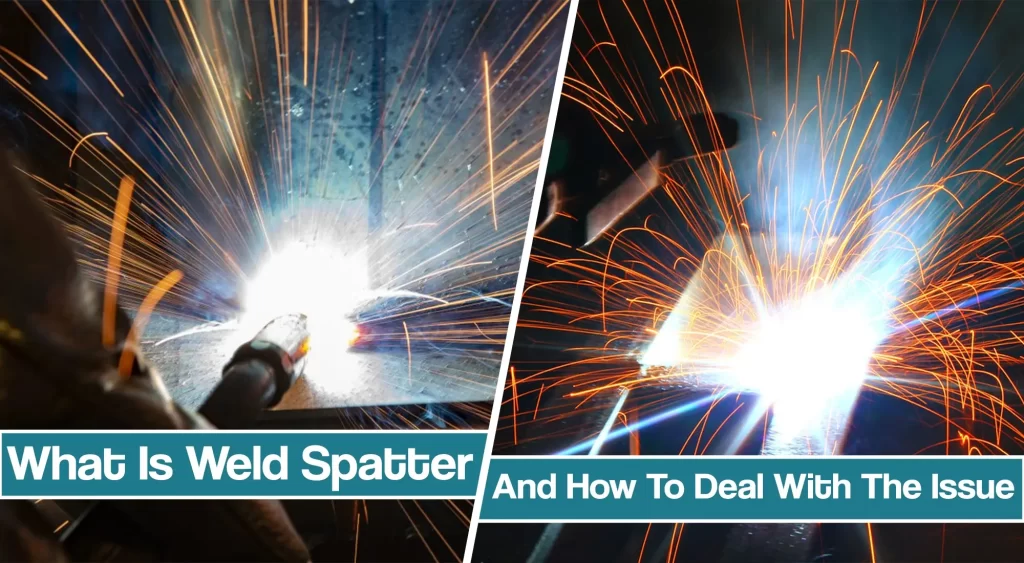
To help you deal with the problem, you must first understand why and how welding spatters occur. This comprehensive article will help you understand and reduce spatter during welding.
What is Weld Spatter?
Weld spatter is formed from droplets of molten metal or non-metallic material that can be produced during a welding process. The drops of hot material can spray or splash from the weld and hit the workbench, floor, base material, or surrounding area. As they cool, they form small round balls of material where they landed.
Spatter is generally regarded as a nuisance and is a critical factor to consider when developing an application.
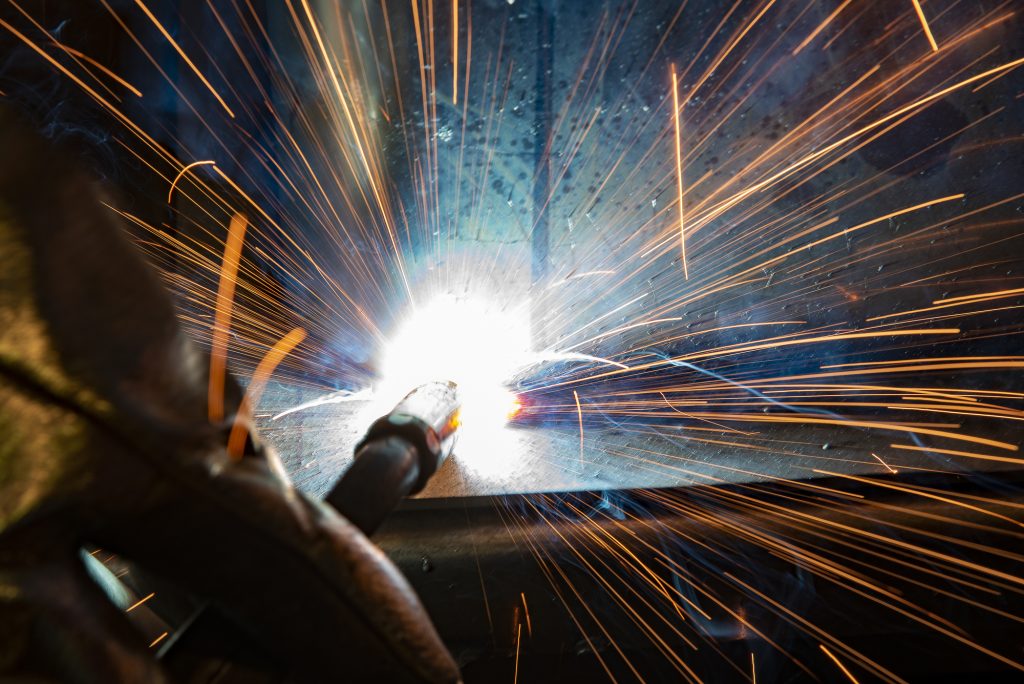
Since you ejected some metal from the weld as a spatter, in severe cases, the integrity of the weld might be questioned, causing a welding defect.
What Causes Welding Spatter and How To Deal With It?
The excessive spatter can be caused by various factors, although the leading cause is a disturbance in the molten weld pool as the welding wire is transferred into the weld. Disruption most commonly occurs due to improper wire feed speed, voltage, or amperage selection.
However, besides welder settings, a common source of excess spatter flying around the workshop might be:
- The composition of base metal
- Protective coating layer
- Dirt or contamination on the surface
- Contaminated filler materials
- Cheap and low-grade filler wire
- Shielding gas choice
- Welding technique
Let’s discuss why each of these factors can cause spatter and how to deal with the issue.
The Composition Of The Base Metal
In certain situations, the varied composition of the base metal can cause spatter. In most cases, metals are alloyed with particular effects to increase their mechanical properties and weldability.
However, some metals are not suitable for welding, and if you try to join them, besides poor arc characteristics, you will have to deal with excess spatter. So, before buying metal just because it is cheap, try to pay attention to its composition.
How To Deal With Excessive Spatter Due To Poor Metal Composition
The easiest way to deal with weld spatter due to the poor composition of the base metal is to opt for higher quality metal. That means sometimes you will have to spend more, but since spatter can be considered one of the welding defects, higher investment is well worth it in this case.
Protective Layer of Coating
Once again, certain metals, such as galvanized steel, have a surface coating that improves their mechanical properties and characteristics, such as oxidation resistance or many more. While these will do good for your metal, you might have to deal with weld spatter once you start welding over them.
As a rule of thumb, the purer the material being welded is, the cleaner the weld will be; hence less spatter. Metal coating can interfere with the characteristics of the entire weld, not just weld spatter, so it is essential to remove it in specific applications.
Dealing With Spatter Caused By Coating
While the coating can melt away while you weld, you will simply have to grind off the protective layer to avoid an initial weld spatter. While grinding steel with a coating, beware of the more expansive heat-affected zone.
Since heat can spread and affect the coating nearby, you will have to grind off the broader area of the weld. That way, you are at risk of minimal spatter.
Dirt or Contamination On The Surface
One of the first things you learn when you start welding is that cleanliness is crucial. Any contaminants such as oil, dirt, dust, or rust and mill scale can interfere with welding bead and eventually spatter.
Once you touch the oil with your hot electrode, it will start boiling, and spatter will fly around the workshop. Therefore, weld quality-wise and spatter-wise, you will have to deal with poor welding surface conditions prior to welding.
Dealing With Spatter Caused By Dirt
The best way to reduce spatter caused by dirt is to prep your metal pieces prior to welding. Depending on the amount of dirt and oil, you can use different methods.
For simple cleaning, use an old rag and water to wipe off any excess dirt. If there is an oxide layer, you will need to use more advanced chemical solutions, or you can grind the fine surfers with various abrasives Overall, spending time on cleaning will reduce the post-weld treatment. We have a whole article on the subject of metal preparation before welding.
Contaminated Filler Metal
Like the dirty surface, contaminated or dirty solid wire or electrode can cause weld spatter and affect weld bead quality. Filler wire can easily get dirty due to poor storage conditions and rust.
Filler wire contamination is easy to miss and ignore, but the higher the level of contamination, the more spatter you will have to deal with. To minimize spatter, you will have to keep them well stored, and here are some tips on how.
Reducing Spatter Caused By Contaminated Filler
The best way to reduce spatter caused by contaminated filler metal is to store it properly. When dealing with stainless rods, you won’t have to worry about rust, but any pieces of dirt or carbon traces can cause weld spatter and affect the weld quality.
Storing conditions can also impact the characteristics of Stick welding electrodes. For example, even though they are protected by a layer of flux, wet or oily rods will produce much more spatter, so it still pays to keep these in a bag or container.
MIG welding wire and flux-cored wire should be always stored in a bag when not used. Moisture can build up on the coil when left without a covering for too long, causing rust to form.
Cheap Filler
Matching your filler and base metal is crucial for satisfying weld results, but when it comes to a choice, you shouldn’t try to save. The filler metal composition will significantly impact welding results, but a low-grade one will cause arc repulsion force or weld spatter.
Even though you can weld with a poor-quality welding wire, it is not recommended if you are trying to avoid too much spatter.
Solving Spatter Caused by a Low-grade Welding Wire
When buying a filler wire, you should first do some research. Read about the composition and other people’s opinions, don’t just opt for the cheapest or the most expensive wire on the market.
Some welders report they had issues with a weld spatter, even with the brand-name wires. So if you are using a new welder, we suggest buying smaller spools to try out how they work with your machine.
Welder Settings
Even though you get the perfect steel, clean all parts and select the proper and well-stored filler, you might still have to deal with excess spatter. Most commonly, the reason is the improper welder settings. As necessary as the quality of the materials you use, you will have the same problem if your welder settings are wrong.
MIG Welding Settings
A common cause of MIG welding spatter excessive wire speed setting or irregularity with your wire feed. Spatter occurs when the filler wire enters the weld pool, or due to improper metal transfer.
The solid wire melts rapidly due to the extreme heat. It turns into a liquid form as it melts, creating the pool. If the wire is hot enough before it hits the steel, you will get a minimal spatter.
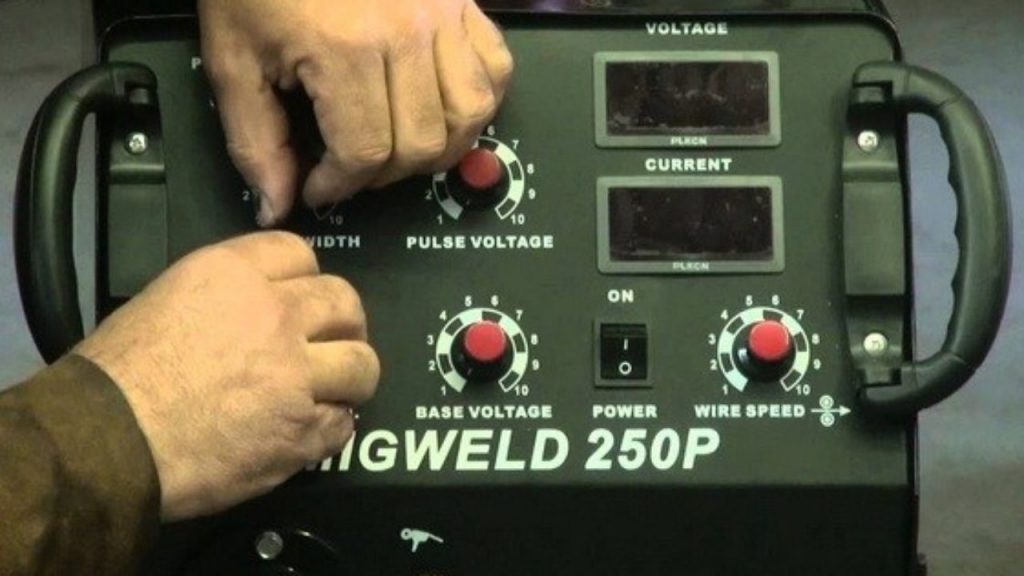
On the other hand, if the filler wire is too cold, it hits the pool before melting and splashes it with spatter flying out. The stick out from the nozzle must also be set correctly. A rule of thumb often stated is ⅜ inch wire sticking. But it can vary based on the geometry of the weld.
In addition, you will need to tune the MIG welder wire feed speed setting right. Too fast, you send solid metal wire into the pool, which causes a disturbance more than adequate to create a spatter. Too slow, and you vaporize the wire before it gets to the weld; again, more spatter.
Stick Welder Settings
The same principle applies to SMAW welding. Your travel speed is connected to the current and/or voltage settings. Too hot, and you must move fast to avoid weld spatter and burn thorough on the thinner pieces.
On the other side, too cold, and your welding is rough. It fluctuates between welding and sticking, which causes spatter and an unsightly weld.
Therefore, dialing your settings in might take some time and patience. Practice on scrap pieces of metal and slowly dial in the settings. If you make significant changes, you risk jumping over the sweet spot, so make sure you do it gradually.
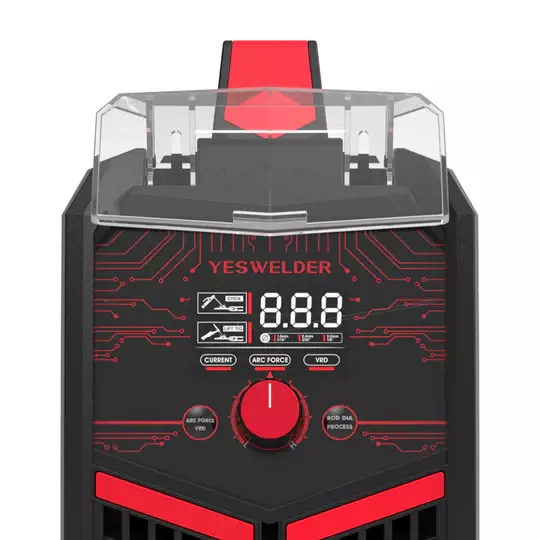
Welding Technique
Next on the list of the weld spatter issues is the welding technique. Even though you got your decent quality steel and filler metal, clean the pieces and dial the settings right, you might still get spatter.
Each welding method requires a lot of practice and a different set of skills. So like tuning the settings, practicing the welding techniques will help you produce minimal spatter.
MIG Welding Skills
You need to get the direction you move while welding right. If you need high, consistent heat, pulling your weld is better. When you need heat distribution, pushing is more appropriate. If you want to learn more about the difference between pushing and pulling, feel free to check out our detailed article.
While consistency in wire speed minimizes spatter, consistency in travel speed and a steady hand ensure a clean weld. The more consistent you can be with the technique your weld requires, the less spatter will occur.
Hence, find the right angle, speed, and line to get the best results, then stick to it.
Stick Welding Technique
Like with MIG welding, you cannot move too fast or slow. Fast travel speed creates more spatter. One of the reasons for moving too fast is that the amperage and voltage may be set too high.
Another thing to make sure you get right is the arc length. In general, keep the arc length equal to the metallic core of the electrode you are using for the stick weld.
Shielding Gas Choice
In addition to welder settings and electrode manipulation, you will need to select propers shielding gas and gas flow. The type of gas you use can have an immense effect on how clean your weld is, which will affect the amount of spatter you produce.
Pure CO2 Gas
Pure CO2 is a common choice in MIG welding due to economics and excellent penetration. It is widely used as a cheap option for thicker metal, but it produces significantly higher weld spatter.
Pure Argon
Pure argon is a common choice in GMAW welding aluminum and TIG welding. While offering excellent arc stability and decent results, it can cause more spatter in GMAW steel welding.
Argon/CO2 Mix
Argon/CO2 mix is a go-to shielding gas choice in GMAW welding. Welding with C25 mixture results in clean welds and decent penetration. The most significant advantage is that this blend has little to no spatter.
Equipment Related Spatter Issues
To produce quality welds, which include reduced spatter, your equipment must be in top-notch condition.
One of the more often overlooked details is the ground clamp. If it is not clean or cannot make good contact with the piece, the current can fluctuate as you weld.
This will create more spatter with both a stick and MIG welder.
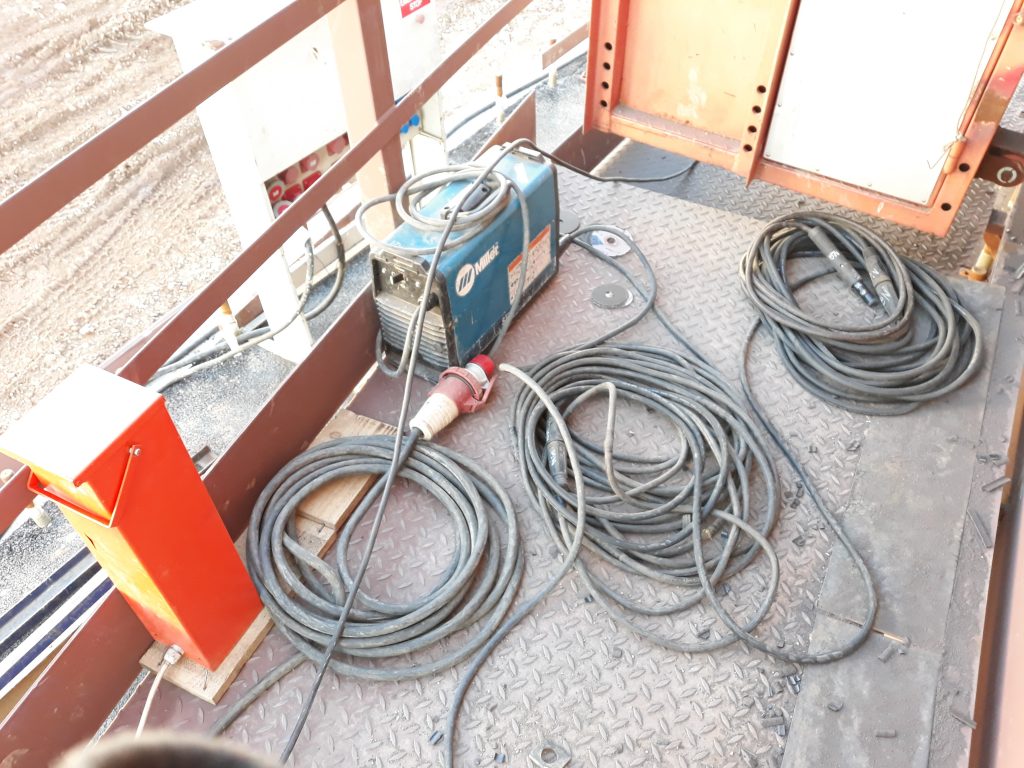
The shielding gas must flow freely at the right rate. Make sure your hoses, regulator, and gas ports are all functioning properly. The contact tip must also be in good condition and properly sized. Even though tips can wear out, a more common source of spatter is using the wrong size.
Other Solutions to Deal and Remove Weld Spatter
While the solutions above are the most crucial in reducing the risk of spatter, there are certain methods you can use to reduce spatter from sticking. Even though it is hard to deal with all the spatter, you can minimize it by using specific solutions such as anti-spatter sprays, welding tape, chipping hammer or grinder.
- Anti-spatter spray is an oil-based product you apply over your welding area and it will prevent spatter from sticking to the metal, leaving mainly loose balls on your project. It is a useful product you will appreciate, but some spatter may still melt into the workpiece.
- Welding tape is generally made from aluminum and you apply it when you want to keep spatter away. However, you cannot use it directly where you weld like anti-spatter spray. Even though it is an expensive option, the tape might be a critical part of projects.
- A chipping hammer is a solution when there are still a few spots of spatter over your workpiece. With spring in the handle and a cold chisel head, a spatter hammer will easily chip away everything left on your job.
- The grinder is a great last resort. It won’t chip off the residue like a spatter hammer, but it will grind it away to a clean finish.
Resources:
- https://www.daihen-usa.com/weld-spatter/
- https://americantorchtip.com/blog/5-tips-to-reduce-excess-mig-spatter/
- https://www.twi-global.com/technical-knowledge/faqs/what-is-weld-spatter
- https://www.hobartbrothers.com/2020/09/spatter-welding/
- https://weldinganswers.com/7-causes-of-spatter-and-how-to-eliminate-them/





